Case Study: Volkswagen's CSR Failures, Ethical Lapses, and Leadership
VerifiedAdded on 2023/04/23
|17
|5964
|284
Case Study
AI Summary
This case study examines Volkswagen's failure to effectively integrate corporate social responsibility (CSR) into its business practices, focusing on the emission cheating scandal. The analysis identifies three major problems: a deficient ethical culture and standards, a lack of leadership quality, and inadequate self-regulation of CSR. The consequences of these failures include significant damage to Volkswagen's reputation, financial penalties, and decreased market value. The report proposes solutions such as restructuring the organizational culture, changing leadership, improving managerial transparency, implementing stricter ethical guidelines, and establishing a robust monitoring system. Recommendations emphasize regulatory measures, external audits, and a commitment to the triple bottom line to ensure long-term sustainability and ethical conduct.
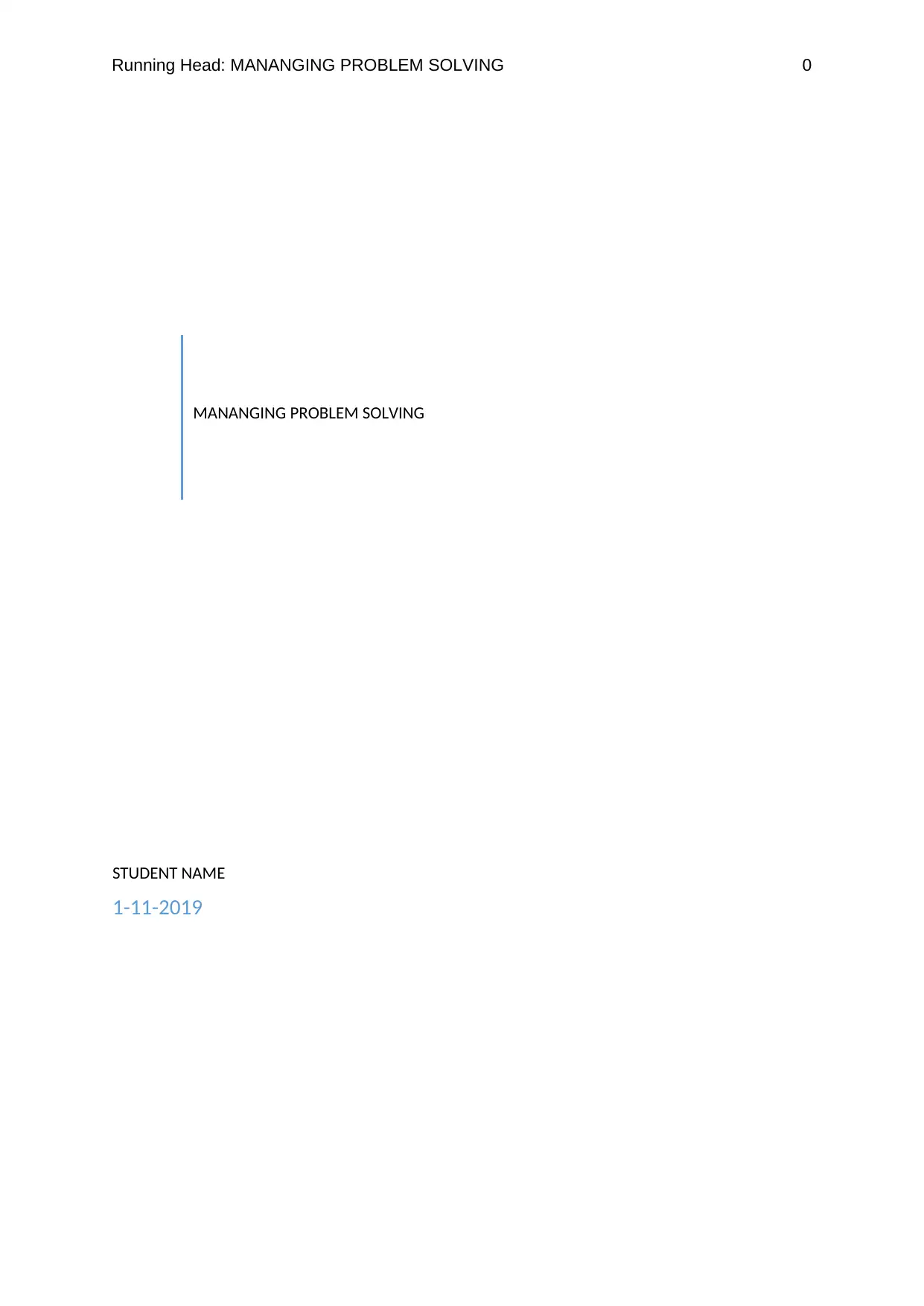
Running Head: MANANGING PROBLEM SOLVING 0
MANANGING PROBLEM SOLVING
STUDENT NAME
1-11-2019
MANANGING PROBLEM SOLVING
STUDENT NAME
1-11-2019
Paraphrase This Document
Need a fresh take? Get an instant paraphrase of this document with our AI Paraphraser
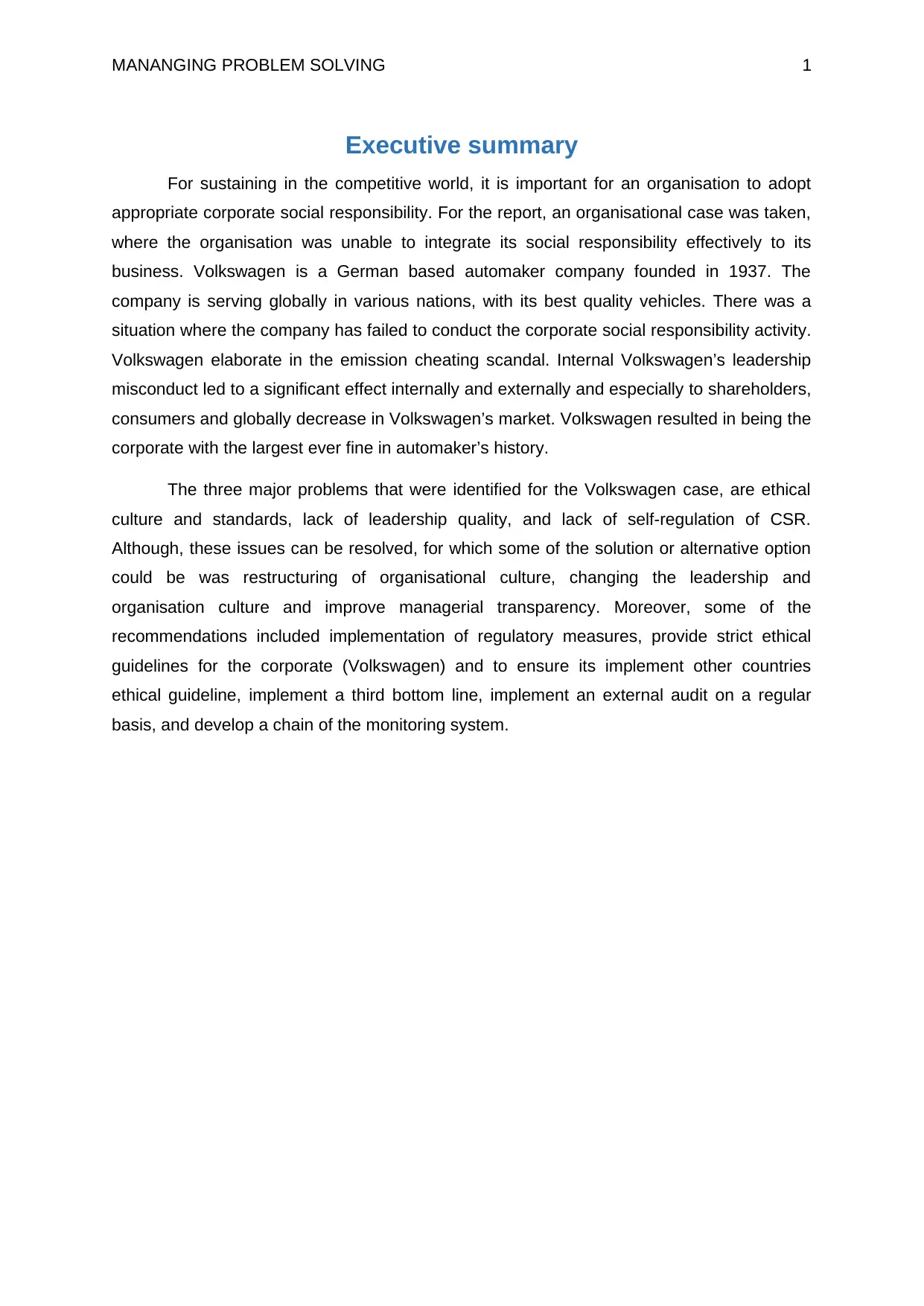
MANANGING PROBLEM SOLVING 1
Executive summary
For sustaining in the competitive world, it is important for an organisation to adopt
appropriate corporate social responsibility. For the report, an organisational case was taken,
where the organisation was unable to integrate its social responsibility effectively to its
business. Volkswagen is a German based automaker company founded in 1937. The
company is serving globally in various nations, with its best quality vehicles. There was a
situation where the company has failed to conduct the corporate social responsibility activity.
Volkswagen elaborate in the emission cheating scandal. Internal Volkswagen’s leadership
misconduct led to a significant effect internally and externally and especially to shareholders,
consumers and globally decrease in Volkswagen’s market. Volkswagen resulted in being the
corporate with the largest ever fine in automaker’s history.
The three major problems that were identified for the Volkswagen case, are ethical
culture and standards, lack of leadership quality, and lack of self-regulation of CSR.
Although, these issues can be resolved, for which some of the solution or alternative option
could be was restructuring of organisational culture, changing the leadership and
organisation culture and improve managerial transparency. Moreover, some of the
recommendations included implementation of regulatory measures, provide strict ethical
guidelines for the corporate (Volkswagen) and to ensure its implement other countries
ethical guideline, implement a third bottom line, implement an external audit on a regular
basis, and develop a chain of the monitoring system.
Executive summary
For sustaining in the competitive world, it is important for an organisation to adopt
appropriate corporate social responsibility. For the report, an organisational case was taken,
where the organisation was unable to integrate its social responsibility effectively to its
business. Volkswagen is a German based automaker company founded in 1937. The
company is serving globally in various nations, with its best quality vehicles. There was a
situation where the company has failed to conduct the corporate social responsibility activity.
Volkswagen elaborate in the emission cheating scandal. Internal Volkswagen’s leadership
misconduct led to a significant effect internally and externally and especially to shareholders,
consumers and globally decrease in Volkswagen’s market. Volkswagen resulted in being the
corporate with the largest ever fine in automaker’s history.
The three major problems that were identified for the Volkswagen case, are ethical
culture and standards, lack of leadership quality, and lack of self-regulation of CSR.
Although, these issues can be resolved, for which some of the solution or alternative option
could be was restructuring of organisational culture, changing the leadership and
organisation culture and improve managerial transparency. Moreover, some of the
recommendations included implementation of regulatory measures, provide strict ethical
guidelines for the corporate (Volkswagen) and to ensure its implement other countries
ethical guideline, implement a third bottom line, implement an external audit on a regular
basis, and develop a chain of the monitoring system.
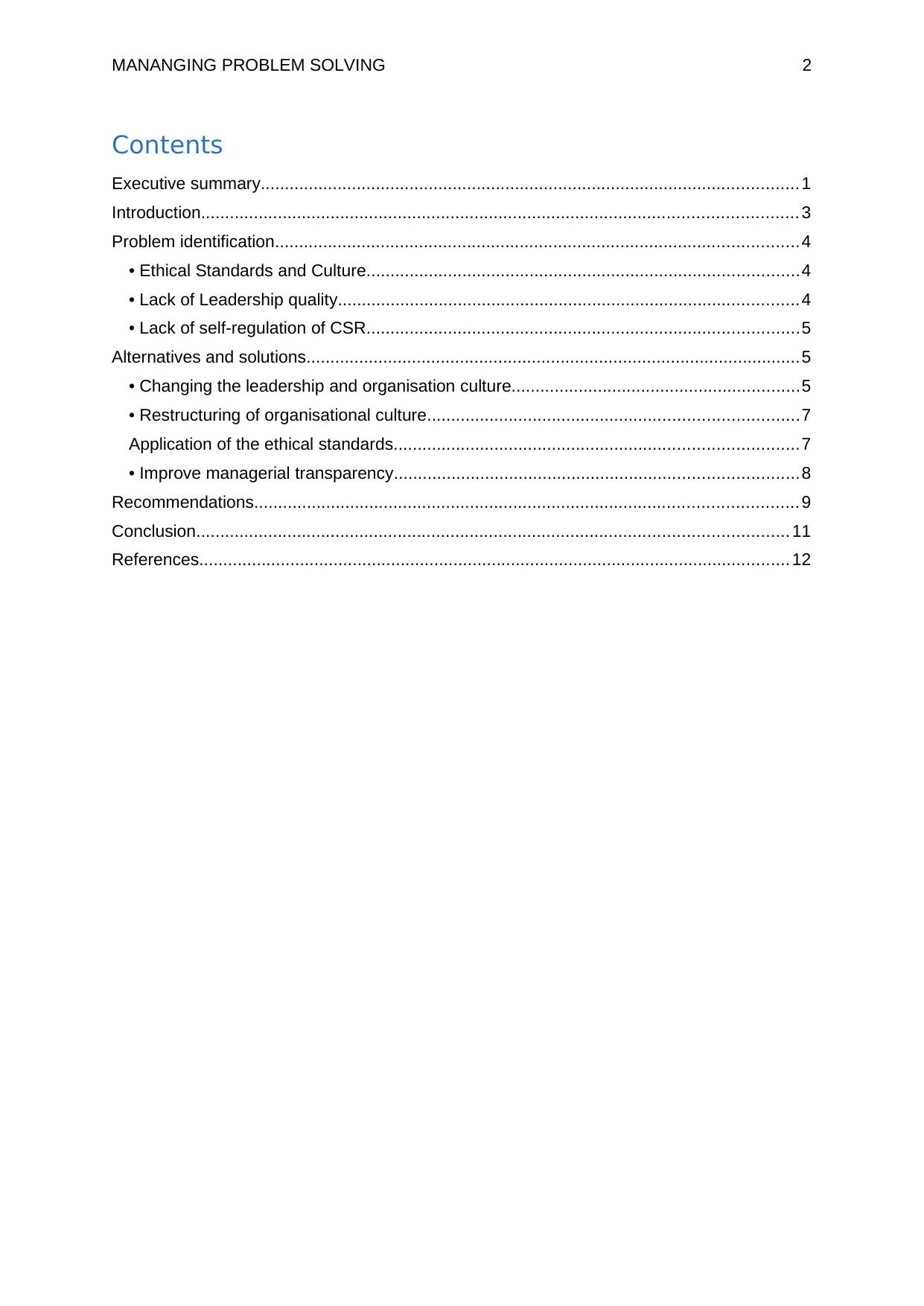
MANANGING PROBLEM SOLVING 2
Contents
Executive summary................................................................................................................ 1
Introduction............................................................................................................................ 3
Problem identification.............................................................................................................4
• Ethical Standards and Culture..........................................................................................4
• Lack of Leadership quality................................................................................................4
• Lack of self-regulation of CSR..........................................................................................5
Alternatives and solutions.......................................................................................................5
• Changing the leadership and organisation culture............................................................5
• Restructuring of organisational culture.............................................................................7
Application of the ethical standards....................................................................................7
• Improve managerial transparency....................................................................................8
Recommendations................................................................................................................. 9
Conclusion........................................................................................................................... 11
References........................................................................................................................... 12
Contents
Executive summary................................................................................................................ 1
Introduction............................................................................................................................ 3
Problem identification.............................................................................................................4
• Ethical Standards and Culture..........................................................................................4
• Lack of Leadership quality................................................................................................4
• Lack of self-regulation of CSR..........................................................................................5
Alternatives and solutions.......................................................................................................5
• Changing the leadership and organisation culture............................................................5
• Restructuring of organisational culture.............................................................................7
Application of the ethical standards....................................................................................7
• Improve managerial transparency....................................................................................8
Recommendations................................................................................................................. 9
Conclusion........................................................................................................................... 11
References........................................................................................................................... 12
⊘ This is a preview!⊘
Do you want full access?
Subscribe today to unlock all pages.

Trusted by 1+ million students worldwide
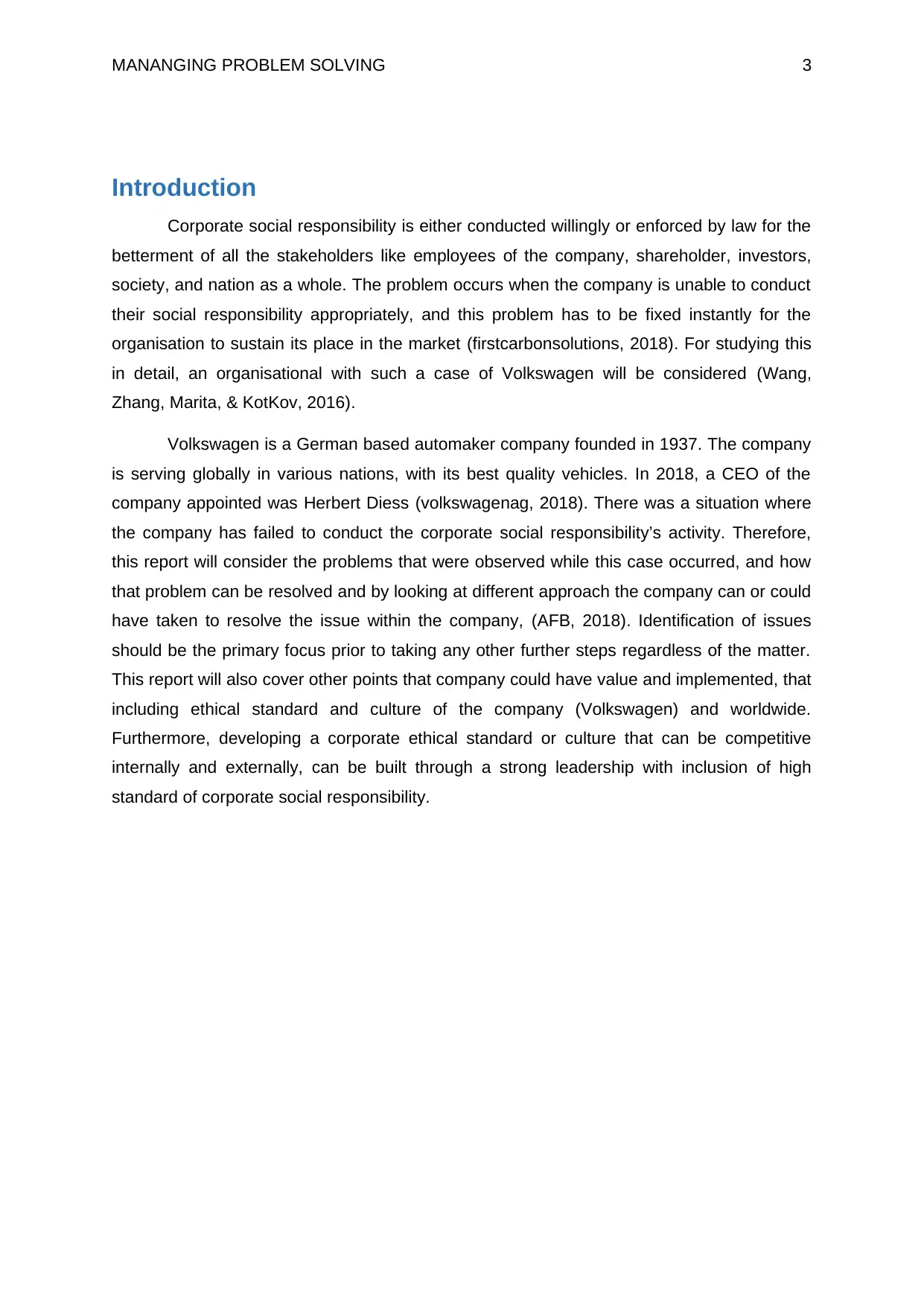
MANANGING PROBLEM SOLVING 3
Introduction
Corporate social responsibility is either conducted willingly or enforced by law for the
betterment of all the stakeholders like employees of the company, shareholder, investors,
society, and nation as a whole. The problem occurs when the company is unable to conduct
their social responsibility appropriately, and this problem has to be fixed instantly for the
organisation to sustain its place in the market (firstcarbonsolutions, 2018). For studying this
in detail, an organisational with such a case of Volkswagen will be considered (Wang,
Zhang, Marita, & KotKov, 2016).
Volkswagen is a German based automaker company founded in 1937. The company
is serving globally in various nations, with its best quality vehicles. In 2018, a CEO of the
company appointed was Herbert Diess (volkswagenag, 2018). There was a situation where
the company has failed to conduct the corporate social responsibility’s activity. Therefore,
this report will consider the problems that were observed while this case occurred, and how
that problem can be resolved and by looking at different approach the company can or could
have taken to resolve the issue within the company, (AFB, 2018). Identification of issues
should be the primary focus prior to taking any other further steps regardless of the matter.
This report will also cover other points that company could have value and implemented, that
including ethical standard and culture of the company (Volkswagen) and worldwide.
Furthermore, developing a corporate ethical standard or culture that can be competitive
internally and externally, can be built through a strong leadership with inclusion of high
standard of corporate social responsibility.
Introduction
Corporate social responsibility is either conducted willingly or enforced by law for the
betterment of all the stakeholders like employees of the company, shareholder, investors,
society, and nation as a whole. The problem occurs when the company is unable to conduct
their social responsibility appropriately, and this problem has to be fixed instantly for the
organisation to sustain its place in the market (firstcarbonsolutions, 2018). For studying this
in detail, an organisational with such a case of Volkswagen will be considered (Wang,
Zhang, Marita, & KotKov, 2016).
Volkswagen is a German based automaker company founded in 1937. The company
is serving globally in various nations, with its best quality vehicles. In 2018, a CEO of the
company appointed was Herbert Diess (volkswagenag, 2018). There was a situation where
the company has failed to conduct the corporate social responsibility’s activity. Therefore,
this report will consider the problems that were observed while this case occurred, and how
that problem can be resolved and by looking at different approach the company can or could
have taken to resolve the issue within the company, (AFB, 2018). Identification of issues
should be the primary focus prior to taking any other further steps regardless of the matter.
This report will also cover other points that company could have value and implemented, that
including ethical standard and culture of the company (Volkswagen) and worldwide.
Furthermore, developing a corporate ethical standard or culture that can be competitive
internally and externally, can be built through a strong leadership with inclusion of high
standard of corporate social responsibility.
Paraphrase This Document
Need a fresh take? Get an instant paraphrase of this document with our AI Paraphraser
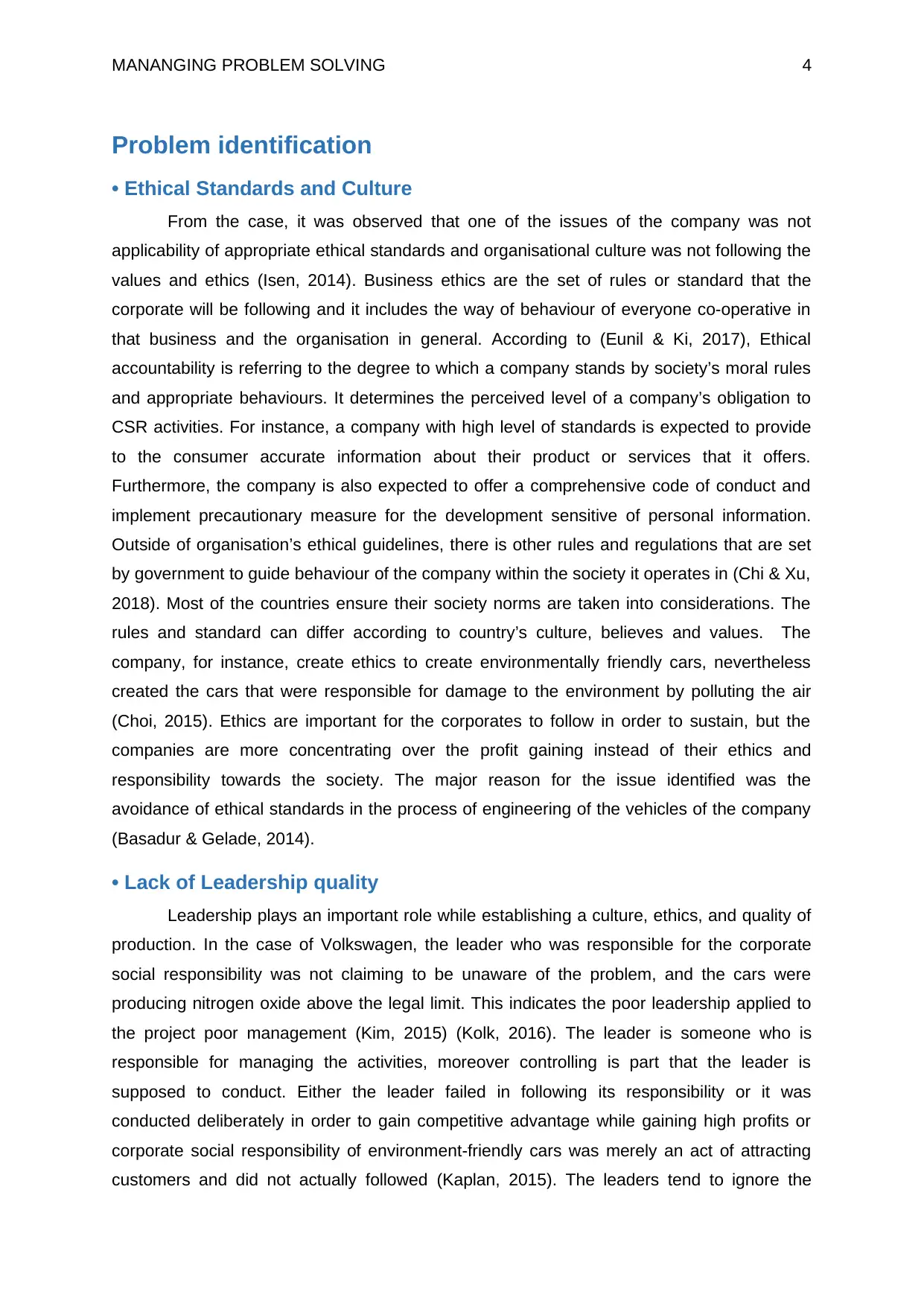
MANANGING PROBLEM SOLVING 4
Problem identification
• Ethical Standards and Culture
From the case, it was observed that one of the issues of the company was not
applicability of appropriate ethical standards and organisational culture was not following the
values and ethics (Isen, 2014). Business ethics are the set of rules or standard that the
corporate will be following and it includes the way of behaviour of everyone co-operative in
that business and the organisation in general. According to (Eunil & Ki, 2017), Ethical
accountability is referring to the degree to which a company stands by society’s moral rules
and appropriate behaviours. It determines the perceived level of a company’s obligation to
CSR activities. For instance, a company with high level of standards is expected to provide
to the consumer accurate information about their product or services that it offers.
Furthermore, the company is also expected to offer a comprehensive code of conduct and
implement precautionary measure for the development sensitive of personal information.
Outside of organisation’s ethical guidelines, there is other rules and regulations that are set
by government to guide behaviour of the company within the society it operates in (Chi & Xu,
2018). Most of the countries ensure their society norms are taken into considerations. The
rules and standard can differ according to country’s culture, believes and values. The
company, for instance, create ethics to create environmentally friendly cars, nevertheless
created the cars that were responsible for damage to the environment by polluting the air
(Choi, 2015). Ethics are important for the corporates to follow in order to sustain, but the
companies are more concentrating over the profit gaining instead of their ethics and
responsibility towards the society. The major reason for the issue identified was the
avoidance of ethical standards in the process of engineering of the vehicles of the company
(Basadur & Gelade, 2014).
• Lack of Leadership quality
Leadership plays an important role while establishing a culture, ethics, and quality of
production. In the case of Volkswagen, the leader who was responsible for the corporate
social responsibility was not claiming to be unaware of the problem, and the cars were
producing nitrogen oxide above the legal limit. This indicates the poor leadership applied to
the project poor management (Kim, 2015) (Kolk, 2016). The leader is someone who is
responsible for managing the activities, moreover controlling is part that the leader is
supposed to conduct. Either the leader failed in following its responsibility or it was
conducted deliberately in order to gain competitive advantage while gaining high profits or
corporate social responsibility of environment-friendly cars was merely an act of attracting
customers and did not actually followed (Kaplan, 2015). The leaders tend to ignore the
Problem identification
• Ethical Standards and Culture
From the case, it was observed that one of the issues of the company was not
applicability of appropriate ethical standards and organisational culture was not following the
values and ethics (Isen, 2014). Business ethics are the set of rules or standard that the
corporate will be following and it includes the way of behaviour of everyone co-operative in
that business and the organisation in general. According to (Eunil & Ki, 2017), Ethical
accountability is referring to the degree to which a company stands by society’s moral rules
and appropriate behaviours. It determines the perceived level of a company’s obligation to
CSR activities. For instance, a company with high level of standards is expected to provide
to the consumer accurate information about their product or services that it offers.
Furthermore, the company is also expected to offer a comprehensive code of conduct and
implement precautionary measure for the development sensitive of personal information.
Outside of organisation’s ethical guidelines, there is other rules and regulations that are set
by government to guide behaviour of the company within the society it operates in (Chi & Xu,
2018). Most of the countries ensure their society norms are taken into considerations. The
rules and standard can differ according to country’s culture, believes and values. The
company, for instance, create ethics to create environmentally friendly cars, nevertheless
created the cars that were responsible for damage to the environment by polluting the air
(Choi, 2015). Ethics are important for the corporates to follow in order to sustain, but the
companies are more concentrating over the profit gaining instead of their ethics and
responsibility towards the society. The major reason for the issue identified was the
avoidance of ethical standards in the process of engineering of the vehicles of the company
(Basadur & Gelade, 2014).
• Lack of Leadership quality
Leadership plays an important role while establishing a culture, ethics, and quality of
production. In the case of Volkswagen, the leader who was responsible for the corporate
social responsibility was not claiming to be unaware of the problem, and the cars were
producing nitrogen oxide above the legal limit. This indicates the poor leadership applied to
the project poor management (Kim, 2015) (Kolk, 2016). The leader is someone who is
responsible for managing the activities, moreover controlling is part that the leader is
supposed to conduct. Either the leader failed in following its responsibility or it was
conducted deliberately in order to gain competitive advantage while gaining high profits or
corporate social responsibility of environment-friendly cars was merely an act of attracting
customers and did not actually followed (Kaplan, 2015). The leaders tend to ignore the
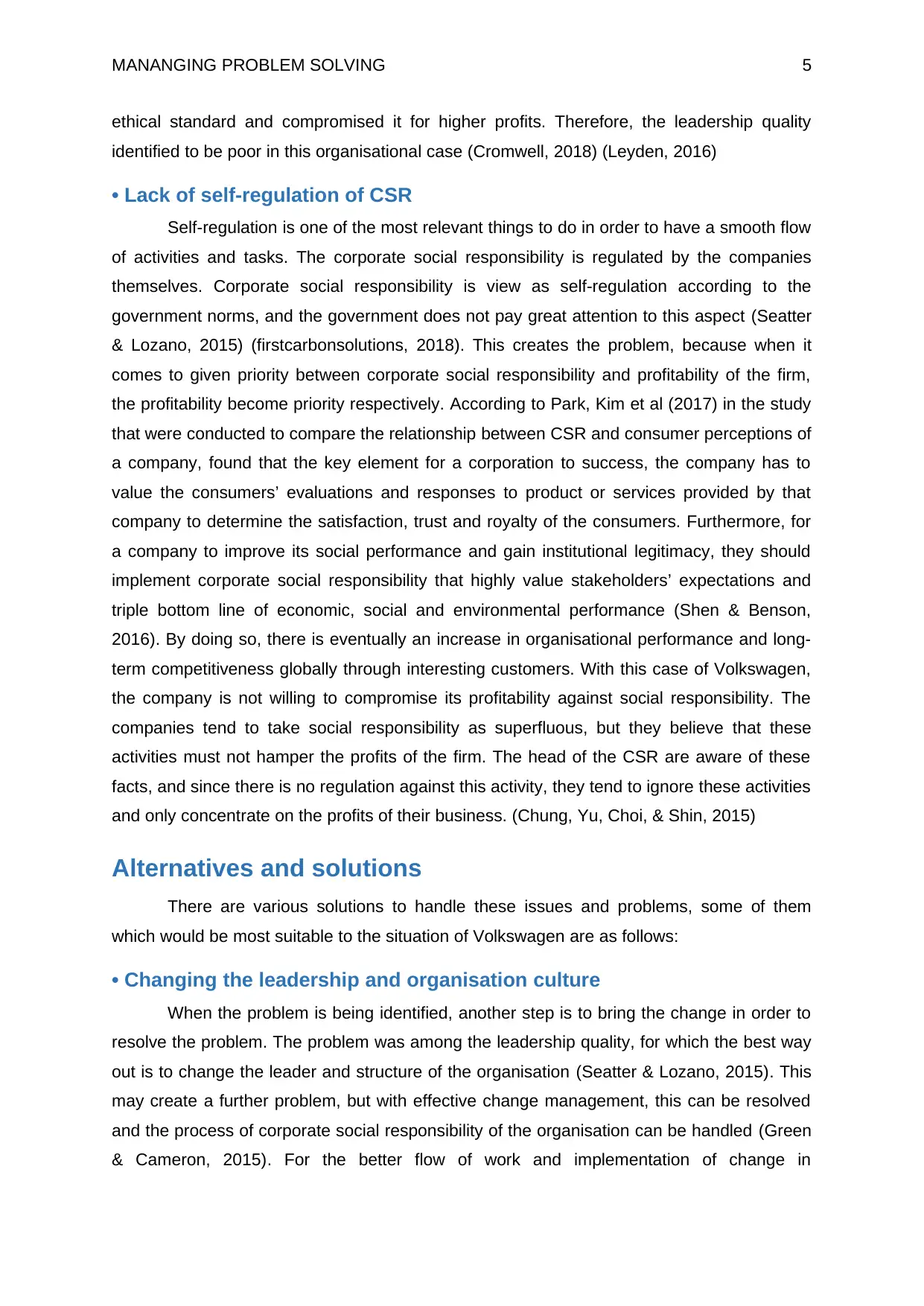
MANANGING PROBLEM SOLVING 5
ethical standard and compromised it for higher profits. Therefore, the leadership quality
identified to be poor in this organisational case (Cromwell, 2018) (Leyden, 2016)
• Lack of self-regulation of CSR
Self-regulation is one of the most relevant things to do in order to have a smooth flow
of activities and tasks. The corporate social responsibility is regulated by the companies
themselves. Corporate social responsibility is view as self-regulation according to the
government norms, and the government does not pay great attention to this aspect (Seatter
& Lozano, 2015) (firstcarbonsolutions, 2018). This creates the problem, because when it
comes to given priority between corporate social responsibility and profitability of the firm,
the profitability become priority respectively. According to Park, Kim et al (2017) in the study
that were conducted to compare the relationship between CSR and consumer perceptions of
a company, found that the key element for a corporation to success, the company has to
value the consumers’ evaluations and responses to product or services provided by that
company to determine the satisfaction, trust and royalty of the consumers. Furthermore, for
a company to improve its social performance and gain institutional legitimacy, they should
implement corporate social responsibility that highly value stakeholders’ expectations and
triple bottom line of economic, social and environmental performance (Shen & Benson,
2016). By doing so, there is eventually an increase in organisational performance and long-
term competitiveness globally through interesting customers. With this case of Volkswagen,
the company is not willing to compromise its profitability against social responsibility. The
companies tend to take social responsibility as superfluous, but they believe that these
activities must not hamper the profits of the firm. The head of the CSR are aware of these
facts, and since there is no regulation against this activity, they tend to ignore these activities
and only concentrate on the profits of their business. (Chung, Yu, Choi, & Shin, 2015)
Alternatives and solutions
There are various solutions to handle these issues and problems, some of them
which would be most suitable to the situation of Volkswagen are as follows:
• Changing the leadership and organisation culture
When the problem is being identified, another step is to bring the change in order to
resolve the problem. The problem was among the leadership quality, for which the best way
out is to change the leader and structure of the organisation (Seatter & Lozano, 2015). This
may create a further problem, but with effective change management, this can be resolved
and the process of corporate social responsibility of the organisation can be handled (Green
& Cameron, 2015). For the better flow of work and implementation of change in
ethical standard and compromised it for higher profits. Therefore, the leadership quality
identified to be poor in this organisational case (Cromwell, 2018) (Leyden, 2016)
• Lack of self-regulation of CSR
Self-regulation is one of the most relevant things to do in order to have a smooth flow
of activities and tasks. The corporate social responsibility is regulated by the companies
themselves. Corporate social responsibility is view as self-regulation according to the
government norms, and the government does not pay great attention to this aspect (Seatter
& Lozano, 2015) (firstcarbonsolutions, 2018). This creates the problem, because when it
comes to given priority between corporate social responsibility and profitability of the firm,
the profitability become priority respectively. According to Park, Kim et al (2017) in the study
that were conducted to compare the relationship between CSR and consumer perceptions of
a company, found that the key element for a corporation to success, the company has to
value the consumers’ evaluations and responses to product or services provided by that
company to determine the satisfaction, trust and royalty of the consumers. Furthermore, for
a company to improve its social performance and gain institutional legitimacy, they should
implement corporate social responsibility that highly value stakeholders’ expectations and
triple bottom line of economic, social and environmental performance (Shen & Benson,
2016). By doing so, there is eventually an increase in organisational performance and long-
term competitiveness globally through interesting customers. With this case of Volkswagen,
the company is not willing to compromise its profitability against social responsibility. The
companies tend to take social responsibility as superfluous, but they believe that these
activities must not hamper the profits of the firm. The head of the CSR are aware of these
facts, and since there is no regulation against this activity, they tend to ignore these activities
and only concentrate on the profits of their business. (Chung, Yu, Choi, & Shin, 2015)
Alternatives and solutions
There are various solutions to handle these issues and problems, some of them
which would be most suitable to the situation of Volkswagen are as follows:
• Changing the leadership and organisation culture
When the problem is being identified, another step is to bring the change in order to
resolve the problem. The problem was among the leadership quality, for which the best way
out is to change the leader and structure of the organisation (Seatter & Lozano, 2015). This
may create a further problem, but with effective change management, this can be resolved
and the process of corporate social responsibility of the organisation can be handled (Green
& Cameron, 2015). For the better flow of work and implementation of change in
⊘ This is a preview!⊘
Do you want full access?
Subscribe today to unlock all pages.

Trusted by 1+ million students worldwide
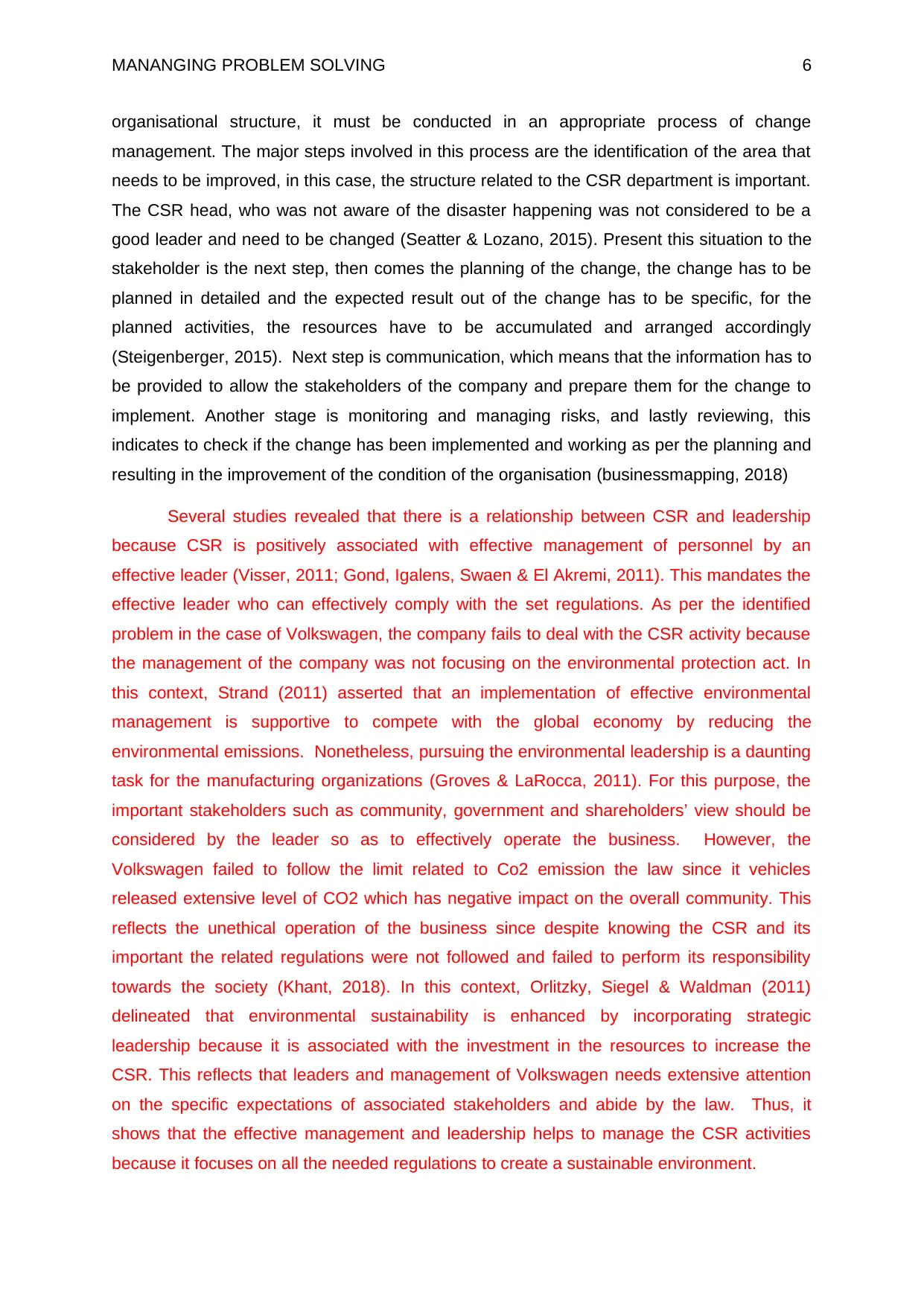
MANANGING PROBLEM SOLVING 6
organisational structure, it must be conducted in an appropriate process of change
management. The major steps involved in this process are the identification of the area that
needs to be improved, in this case, the structure related to the CSR department is important.
The CSR head, who was not aware of the disaster happening was not considered to be a
good leader and need to be changed (Seatter & Lozano, 2015). Present this situation to the
stakeholder is the next step, then comes the planning of the change, the change has to be
planned in detailed and the expected result out of the change has to be specific, for the
planned activities, the resources have to be accumulated and arranged accordingly
(Steigenberger, 2015). Next step is communication, which means that the information has to
be provided to allow the stakeholders of the company and prepare them for the change to
implement. Another stage is monitoring and managing risks, and lastly reviewing, this
indicates to check if the change has been implemented and working as per the planning and
resulting in the improvement of the condition of the organisation (businessmapping, 2018)
Several studies revealed that there is a relationship between CSR and leadership
because CSR is positively associated with effective management of personnel by an
effective leader (Visser, 2011; Gond, Igalens, Swaen & El Akremi, 2011). This mandates the
effective leader who can effectively comply with the set regulations. As per the identified
problem in the case of Volkswagen, the company fails to deal with the CSR activity because
the management of the company was not focusing on the environmental protection act. In
this context, Strand (2011) asserted that an implementation of effective environmental
management is supportive to compete with the global economy by reducing the
environmental emissions. Nonetheless, pursuing the environmental leadership is a daunting
task for the manufacturing organizations (Groves & LaRocca, 2011). For this purpose, the
important stakeholders such as community, government and shareholders’ view should be
considered by the leader so as to effectively operate the business. However, the
Volkswagen failed to follow the limit related to Co2 emission the law since it vehicles
released extensive level of CO2 which has negative impact on the overall community. This
reflects the unethical operation of the business since despite knowing the CSR and its
important the related regulations were not followed and failed to perform its responsibility
towards the society (Khant, 2018). In this context, Orlitzky, Siegel & Waldman (2011)
delineated that environmental sustainability is enhanced by incorporating strategic
leadership because it is associated with the investment in the resources to increase the
CSR. This reflects that leaders and management of Volkswagen needs extensive attention
on the specific expectations of associated stakeholders and abide by the law. Thus, it
shows that the effective management and leadership helps to manage the CSR activities
because it focuses on all the needed regulations to create a sustainable environment.
organisational structure, it must be conducted in an appropriate process of change
management. The major steps involved in this process are the identification of the area that
needs to be improved, in this case, the structure related to the CSR department is important.
The CSR head, who was not aware of the disaster happening was not considered to be a
good leader and need to be changed (Seatter & Lozano, 2015). Present this situation to the
stakeholder is the next step, then comes the planning of the change, the change has to be
planned in detailed and the expected result out of the change has to be specific, for the
planned activities, the resources have to be accumulated and arranged accordingly
(Steigenberger, 2015). Next step is communication, which means that the information has to
be provided to allow the stakeholders of the company and prepare them for the change to
implement. Another stage is monitoring and managing risks, and lastly reviewing, this
indicates to check if the change has been implemented and working as per the planning and
resulting in the improvement of the condition of the organisation (businessmapping, 2018)
Several studies revealed that there is a relationship between CSR and leadership
because CSR is positively associated with effective management of personnel by an
effective leader (Visser, 2011; Gond, Igalens, Swaen & El Akremi, 2011). This mandates the
effective leader who can effectively comply with the set regulations. As per the identified
problem in the case of Volkswagen, the company fails to deal with the CSR activity because
the management of the company was not focusing on the environmental protection act. In
this context, Strand (2011) asserted that an implementation of effective environmental
management is supportive to compete with the global economy by reducing the
environmental emissions. Nonetheless, pursuing the environmental leadership is a daunting
task for the manufacturing organizations (Groves & LaRocca, 2011). For this purpose, the
important stakeholders such as community, government and shareholders’ view should be
considered by the leader so as to effectively operate the business. However, the
Volkswagen failed to follow the limit related to Co2 emission the law since it vehicles
released extensive level of CO2 which has negative impact on the overall community. This
reflects the unethical operation of the business since despite knowing the CSR and its
important the related regulations were not followed and failed to perform its responsibility
towards the society (Khant, 2018). In this context, Orlitzky, Siegel & Waldman (2011)
delineated that environmental sustainability is enhanced by incorporating strategic
leadership because it is associated with the investment in the resources to increase the
CSR. This reflects that leaders and management of Volkswagen needs extensive attention
on the specific expectations of associated stakeholders and abide by the law. Thus, it
shows that the effective management and leadership helps to manage the CSR activities
because it focuses on all the needed regulations to create a sustainable environment.
Paraphrase This Document
Need a fresh take? Get an instant paraphrase of this document with our AI Paraphraser
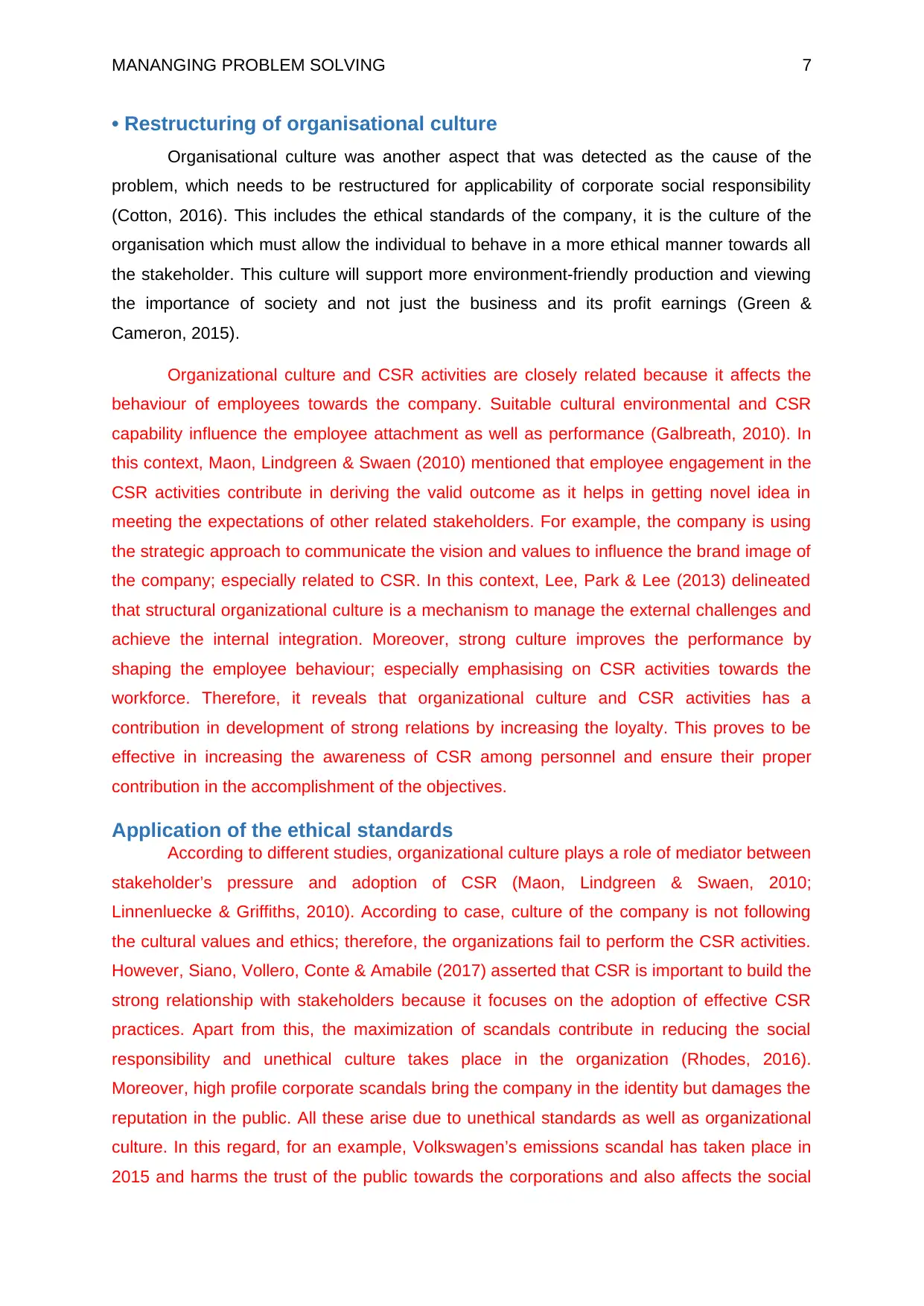
MANANGING PROBLEM SOLVING 7
• Restructuring of organisational culture
Organisational culture was another aspect that was detected as the cause of the
problem, which needs to be restructured for applicability of corporate social responsibility
(Cotton, 2016). This includes the ethical standards of the company, it is the culture of the
organisation which must allow the individual to behave in a more ethical manner towards all
the stakeholder. This culture will support more environment-friendly production and viewing
the importance of society and not just the business and its profit earnings (Green &
Cameron, 2015).
Organizational culture and CSR activities are closely related because it affects the
behaviour of employees towards the company. Suitable cultural environmental and CSR
capability influence the employee attachment as well as performance (Galbreath, 2010). In
this context, Maon, Lindgreen & Swaen (2010) mentioned that employee engagement in the
CSR activities contribute in deriving the valid outcome as it helps in getting novel idea in
meeting the expectations of other related stakeholders. For example, the company is using
the strategic approach to communicate the vision and values to influence the brand image of
the company; especially related to CSR. In this context, Lee, Park & Lee (2013) delineated
that structural organizational culture is a mechanism to manage the external challenges and
achieve the internal integration. Moreover, strong culture improves the performance by
shaping the employee behaviour; especially emphasising on CSR activities towards the
workforce. Therefore, it reveals that organizational culture and CSR activities has a
contribution in development of strong relations by increasing the loyalty. This proves to be
effective in increasing the awareness of CSR among personnel and ensure their proper
contribution in the accomplishment of the objectives.
Application of the ethical standards
According to different studies, organizational culture plays a role of mediator between
stakeholder’s pressure and adoption of CSR (Maon, Lindgreen & Swaen, 2010;
Linnenluecke & Griffiths, 2010). According to case, culture of the company is not following
the cultural values and ethics; therefore, the organizations fail to perform the CSR activities.
However, Siano, Vollero, Conte & Amabile (2017) asserted that CSR is important to build the
strong relationship with stakeholders because it focuses on the adoption of effective CSR
practices. Apart from this, the maximization of scandals contribute in reducing the social
responsibility and unethical culture takes place in the organization (Rhodes, 2016).
Moreover, high profile corporate scandals bring the company in the identity but damages the
reputation in the public. All these arise due to unethical standards as well as organizational
culture. In this regard, for an example, Volkswagen’s emissions scandal has taken place in
2015 and harms the trust of the public towards the corporations and also affects the social
• Restructuring of organisational culture
Organisational culture was another aspect that was detected as the cause of the
problem, which needs to be restructured for applicability of corporate social responsibility
(Cotton, 2016). This includes the ethical standards of the company, it is the culture of the
organisation which must allow the individual to behave in a more ethical manner towards all
the stakeholder. This culture will support more environment-friendly production and viewing
the importance of society and not just the business and its profit earnings (Green &
Cameron, 2015).
Organizational culture and CSR activities are closely related because it affects the
behaviour of employees towards the company. Suitable cultural environmental and CSR
capability influence the employee attachment as well as performance (Galbreath, 2010). In
this context, Maon, Lindgreen & Swaen (2010) mentioned that employee engagement in the
CSR activities contribute in deriving the valid outcome as it helps in getting novel idea in
meeting the expectations of other related stakeholders. For example, the company is using
the strategic approach to communicate the vision and values to influence the brand image of
the company; especially related to CSR. In this context, Lee, Park & Lee (2013) delineated
that structural organizational culture is a mechanism to manage the external challenges and
achieve the internal integration. Moreover, strong culture improves the performance by
shaping the employee behaviour; especially emphasising on CSR activities towards the
workforce. Therefore, it reveals that organizational culture and CSR activities has a
contribution in development of strong relations by increasing the loyalty. This proves to be
effective in increasing the awareness of CSR among personnel and ensure their proper
contribution in the accomplishment of the objectives.
Application of the ethical standards
According to different studies, organizational culture plays a role of mediator between
stakeholder’s pressure and adoption of CSR (Maon, Lindgreen & Swaen, 2010;
Linnenluecke & Griffiths, 2010). According to case, culture of the company is not following
the cultural values and ethics; therefore, the organizations fail to perform the CSR activities.
However, Siano, Vollero, Conte & Amabile (2017) asserted that CSR is important to build the
strong relationship with stakeholders because it focuses on the adoption of effective CSR
practices. Apart from this, the maximization of scandals contribute in reducing the social
responsibility and unethical culture takes place in the organization (Rhodes, 2016).
Moreover, high profile corporate scandals bring the company in the identity but damages the
reputation in the public. All these arise due to unethical standards as well as organizational
culture. In this regard, for an example, Volkswagen’s emissions scandal has taken place in
2015 and harms the trust of the public towards the corporations and also affects the social
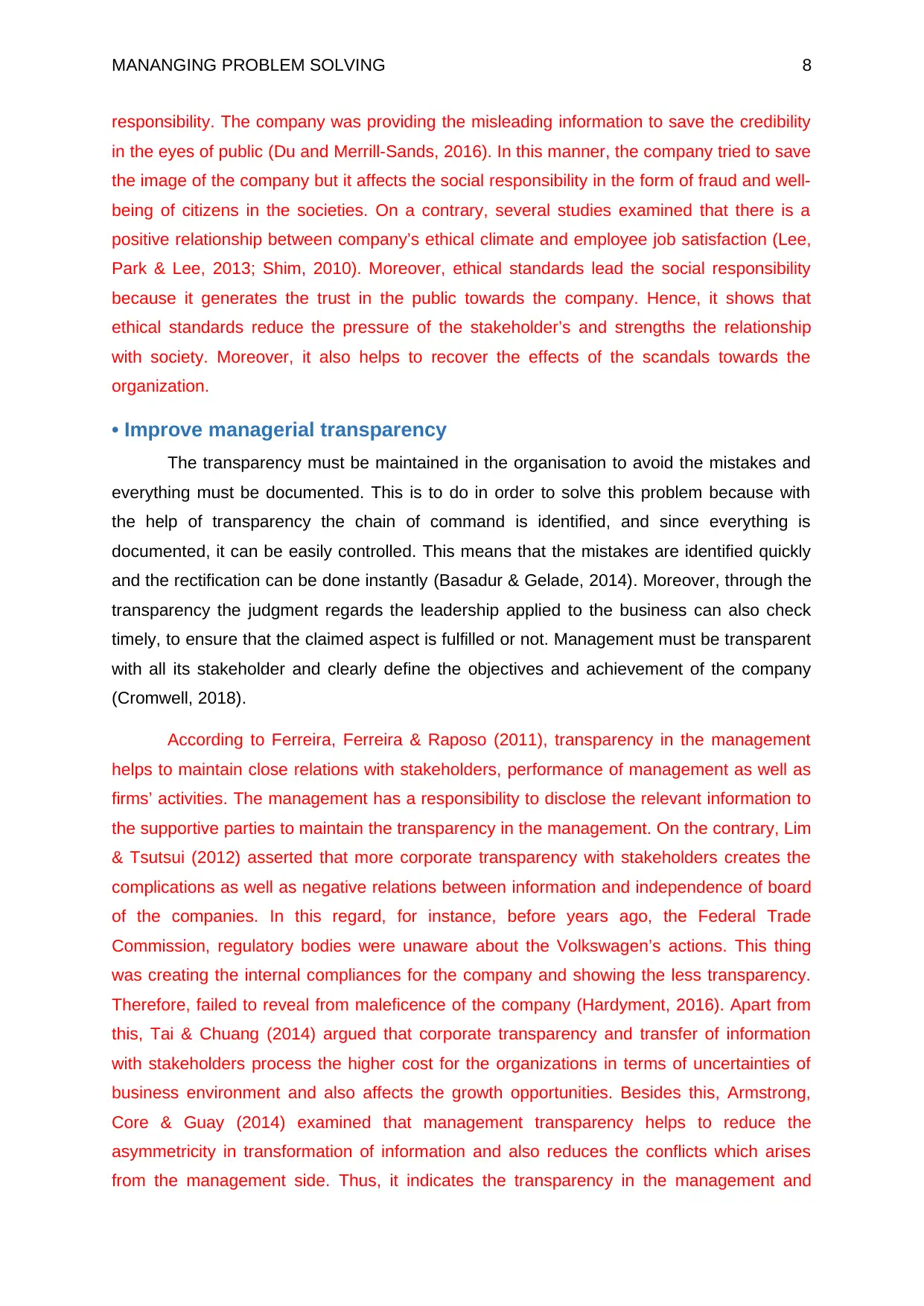
MANANGING PROBLEM SOLVING 8
responsibility. The company was providing the misleading information to save the credibility
in the eyes of public (Du and Merrill-Sands, 2016). In this manner, the company tried to save
the image of the company but it affects the social responsibility in the form of fraud and well-
being of citizens in the societies. On a contrary, several studies examined that there is a
positive relationship between company’s ethical climate and employee job satisfaction (Lee,
Park & Lee, 2013; Shim, 2010). Moreover, ethical standards lead the social responsibility
because it generates the trust in the public towards the company. Hence, it shows that
ethical standards reduce the pressure of the stakeholder’s and strengths the relationship
with society. Moreover, it also helps to recover the effects of the scandals towards the
organization.
• Improve managerial transparency
The transparency must be maintained in the organisation to avoid the mistakes and
everything must be documented. This is to do in order to solve this problem because with
the help of transparency the chain of command is identified, and since everything is
documented, it can be easily controlled. This means that the mistakes are identified quickly
and the rectification can be done instantly (Basadur & Gelade, 2014). Moreover, through the
transparency the judgment regards the leadership applied to the business can also check
timely, to ensure that the claimed aspect is fulfilled or not. Management must be transparent
with all its stakeholder and clearly define the objectives and achievement of the company
(Cromwell, 2018).
According to Ferreira, Ferreira & Raposo (2011), transparency in the management
helps to maintain close relations with stakeholders, performance of management as well as
firms’ activities. The management has a responsibility to disclose the relevant information to
the supportive parties to maintain the transparency in the management. On the contrary, Lim
& Tsutsui (2012) asserted that more corporate transparency with stakeholders creates the
complications as well as negative relations between information and independence of board
of the companies. In this regard, for instance, before years ago, the Federal Trade
Commission, regulatory bodies were unaware about the Volkswagen’s actions. This thing
was creating the internal compliances for the company and showing the less transparency.
Therefore, failed to reveal from maleficence of the company (Hardyment, 2016). Apart from
this, Tai & Chuang (2014) argued that corporate transparency and transfer of information
with stakeholders process the higher cost for the organizations in terms of uncertainties of
business environment and also affects the growth opportunities. Besides this, Armstrong,
Core & Guay (2014) examined that management transparency helps to reduce the
asymmetricity in transformation of information and also reduces the conflicts which arises
from the management side. Thus, it indicates the transparency in the management and
responsibility. The company was providing the misleading information to save the credibility
in the eyes of public (Du and Merrill-Sands, 2016). In this manner, the company tried to save
the image of the company but it affects the social responsibility in the form of fraud and well-
being of citizens in the societies. On a contrary, several studies examined that there is a
positive relationship between company’s ethical climate and employee job satisfaction (Lee,
Park & Lee, 2013; Shim, 2010). Moreover, ethical standards lead the social responsibility
because it generates the trust in the public towards the company. Hence, it shows that
ethical standards reduce the pressure of the stakeholder’s and strengths the relationship
with society. Moreover, it also helps to recover the effects of the scandals towards the
organization.
• Improve managerial transparency
The transparency must be maintained in the organisation to avoid the mistakes and
everything must be documented. This is to do in order to solve this problem because with
the help of transparency the chain of command is identified, and since everything is
documented, it can be easily controlled. This means that the mistakes are identified quickly
and the rectification can be done instantly (Basadur & Gelade, 2014). Moreover, through the
transparency the judgment regards the leadership applied to the business can also check
timely, to ensure that the claimed aspect is fulfilled or not. Management must be transparent
with all its stakeholder and clearly define the objectives and achievement of the company
(Cromwell, 2018).
According to Ferreira, Ferreira & Raposo (2011), transparency in the management
helps to maintain close relations with stakeholders, performance of management as well as
firms’ activities. The management has a responsibility to disclose the relevant information to
the supportive parties to maintain the transparency in the management. On the contrary, Lim
& Tsutsui (2012) asserted that more corporate transparency with stakeholders creates the
complications as well as negative relations between information and independence of board
of the companies. In this regard, for instance, before years ago, the Federal Trade
Commission, regulatory bodies were unaware about the Volkswagen’s actions. This thing
was creating the internal compliances for the company and showing the less transparency.
Therefore, failed to reveal from maleficence of the company (Hardyment, 2016). Apart from
this, Tai & Chuang (2014) argued that corporate transparency and transfer of information
with stakeholders process the higher cost for the organizations in terms of uncertainties of
business environment and also affects the growth opportunities. Besides this, Armstrong,
Core & Guay (2014) examined that management transparency helps to reduce the
asymmetricity in transformation of information and also reduces the conflicts which arises
from the management side. Thus, it indicates the transparency in the management and
⊘ This is a preview!⊘
Do you want full access?
Subscribe today to unlock all pages.

Trusted by 1+ million students worldwide
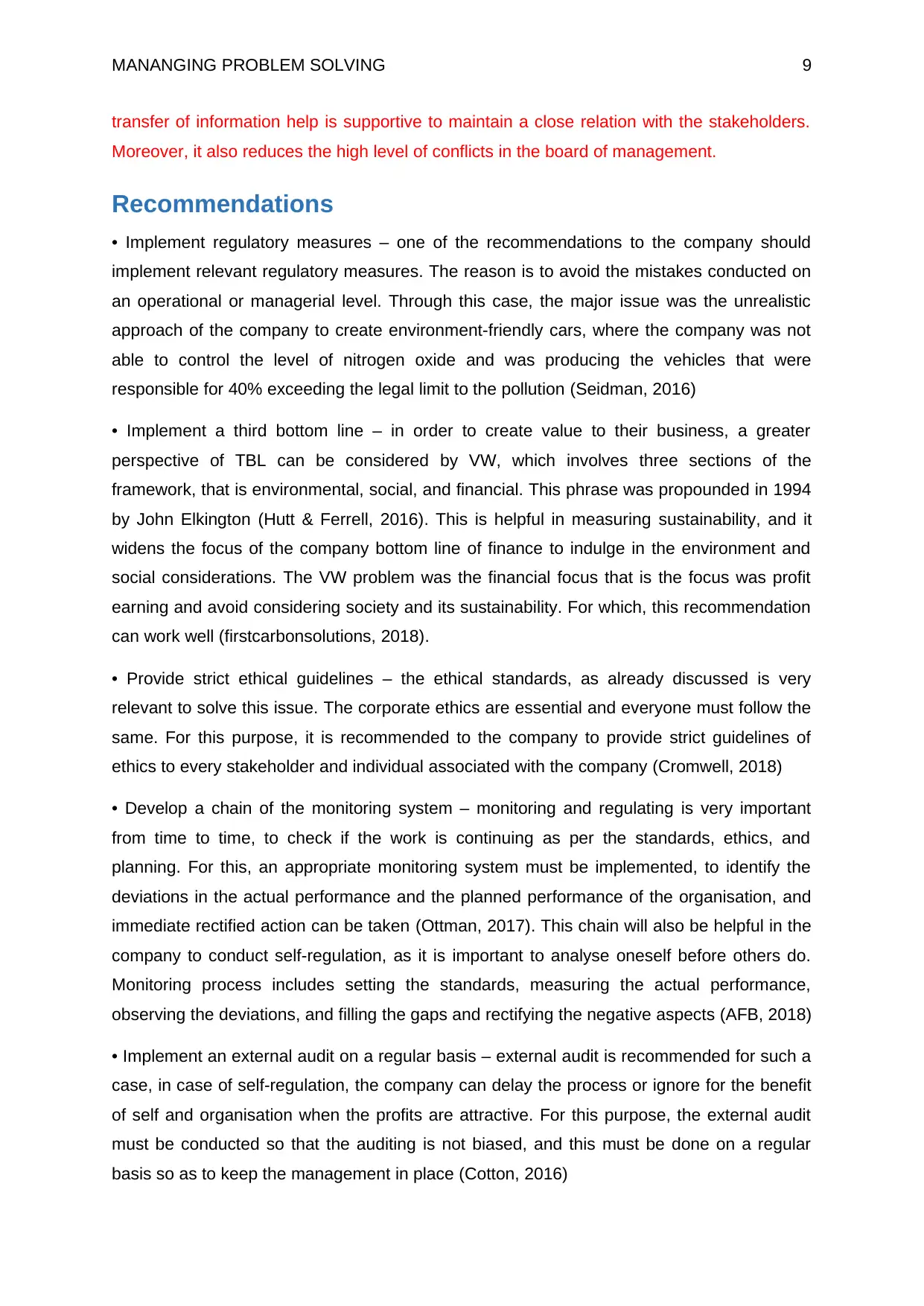
MANANGING PROBLEM SOLVING 9
transfer of information help is supportive to maintain a close relation with the stakeholders.
Moreover, it also reduces the high level of conflicts in the board of management.
Recommendations
• Implement regulatory measures – one of the recommendations to the company should
implement relevant regulatory measures. The reason is to avoid the mistakes conducted on
an operational or managerial level. Through this case, the major issue was the unrealistic
approach of the company to create environment-friendly cars, where the company was not
able to control the level of nitrogen oxide and was producing the vehicles that were
responsible for 40% exceeding the legal limit to the pollution (Seidman, 2016)
• Implement a third bottom line – in order to create value to their business, a greater
perspective of TBL can be considered by VW, which involves three sections of the
framework, that is environmental, social, and financial. This phrase was propounded in 1994
by John Elkington (Hutt & Ferrell, 2016). This is helpful in measuring sustainability, and it
widens the focus of the company bottom line of finance to indulge in the environment and
social considerations. The VW problem was the financial focus that is the focus was profit
earning and avoid considering society and its sustainability. For which, this recommendation
can work well (firstcarbonsolutions, 2018).
• Provide strict ethical guidelines – the ethical standards, as already discussed is very
relevant to solve this issue. The corporate ethics are essential and everyone must follow the
same. For this purpose, it is recommended to the company to provide strict guidelines of
ethics to every stakeholder and individual associated with the company (Cromwell, 2018)
• Develop a chain of the monitoring system – monitoring and regulating is very important
from time to time, to check if the work is continuing as per the standards, ethics, and
planning. For this, an appropriate monitoring system must be implemented, to identify the
deviations in the actual performance and the planned performance of the organisation, and
immediate rectified action can be taken (Ottman, 2017). This chain will also be helpful in the
company to conduct self-regulation, as it is important to analyse oneself before others do.
Monitoring process includes setting the standards, measuring the actual performance,
observing the deviations, and filling the gaps and rectifying the negative aspects (AFB, 2018)
• Implement an external audit on a regular basis – external audit is recommended for such a
case, in case of self-regulation, the company can delay the process or ignore for the benefit
of self and organisation when the profits are attractive. For this purpose, the external audit
must be conducted so that the auditing is not biased, and this must be done on a regular
basis so as to keep the management in place (Cotton, 2016)
transfer of information help is supportive to maintain a close relation with the stakeholders.
Moreover, it also reduces the high level of conflicts in the board of management.
Recommendations
• Implement regulatory measures – one of the recommendations to the company should
implement relevant regulatory measures. The reason is to avoid the mistakes conducted on
an operational or managerial level. Through this case, the major issue was the unrealistic
approach of the company to create environment-friendly cars, where the company was not
able to control the level of nitrogen oxide and was producing the vehicles that were
responsible for 40% exceeding the legal limit to the pollution (Seidman, 2016)
• Implement a third bottom line – in order to create value to their business, a greater
perspective of TBL can be considered by VW, which involves three sections of the
framework, that is environmental, social, and financial. This phrase was propounded in 1994
by John Elkington (Hutt & Ferrell, 2016). This is helpful in measuring sustainability, and it
widens the focus of the company bottom line of finance to indulge in the environment and
social considerations. The VW problem was the financial focus that is the focus was profit
earning and avoid considering society and its sustainability. For which, this recommendation
can work well (firstcarbonsolutions, 2018).
• Provide strict ethical guidelines – the ethical standards, as already discussed is very
relevant to solve this issue. The corporate ethics are essential and everyone must follow the
same. For this purpose, it is recommended to the company to provide strict guidelines of
ethics to every stakeholder and individual associated with the company (Cromwell, 2018)
• Develop a chain of the monitoring system – monitoring and regulating is very important
from time to time, to check if the work is continuing as per the standards, ethics, and
planning. For this, an appropriate monitoring system must be implemented, to identify the
deviations in the actual performance and the planned performance of the organisation, and
immediate rectified action can be taken (Ottman, 2017). This chain will also be helpful in the
company to conduct self-regulation, as it is important to analyse oneself before others do.
Monitoring process includes setting the standards, measuring the actual performance,
observing the deviations, and filling the gaps and rectifying the negative aspects (AFB, 2018)
• Implement an external audit on a regular basis – external audit is recommended for such a
case, in case of self-regulation, the company can delay the process or ignore for the benefit
of self and organisation when the profits are attractive. For this purpose, the external audit
must be conducted so that the auditing is not biased, and this must be done on a regular
basis so as to keep the management in place (Cotton, 2016)
Paraphrase This Document
Need a fresh take? Get an instant paraphrase of this document with our AI Paraphraser

MANANGING PROBLEM SOLVING 10
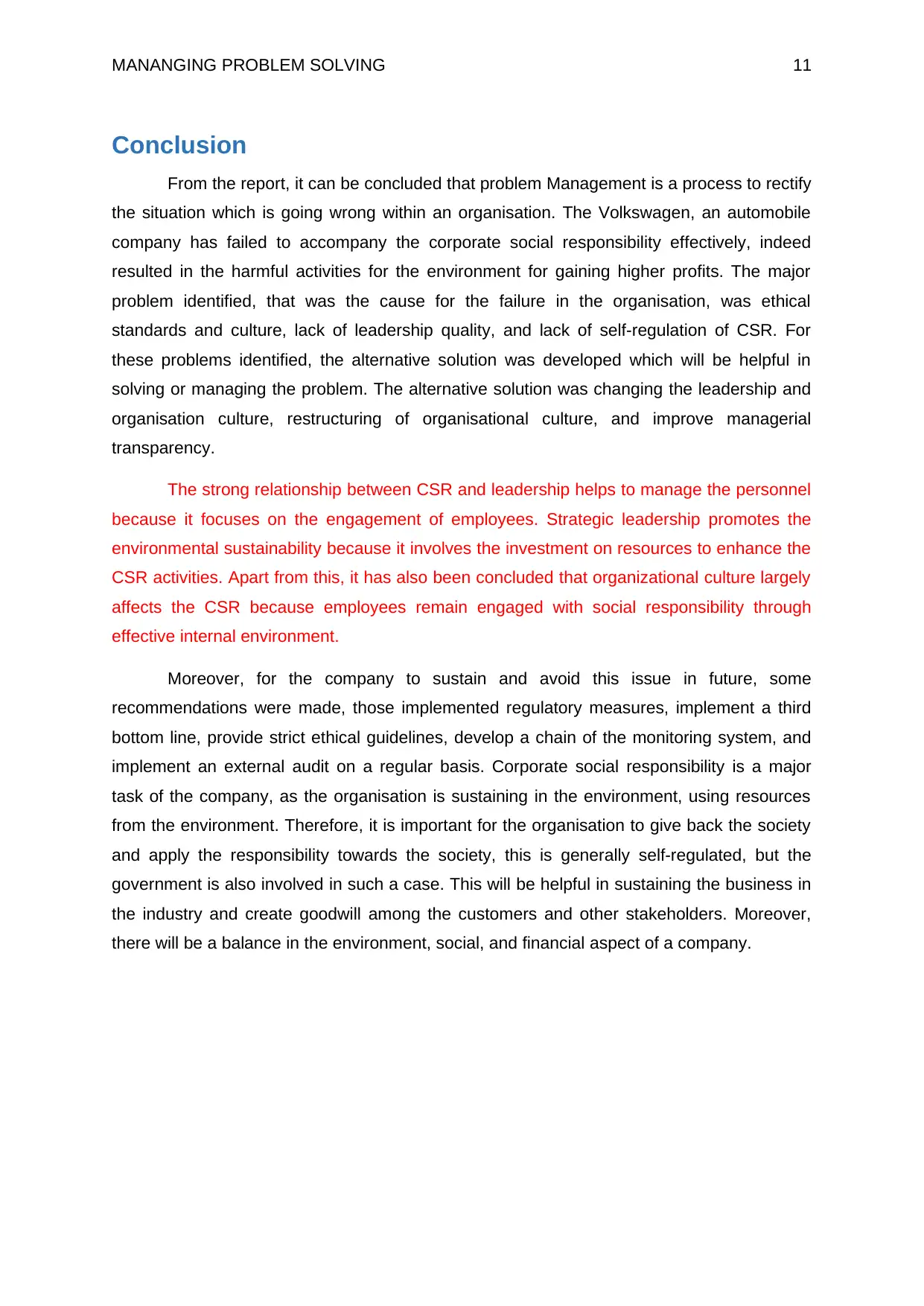
MANANGING PROBLEM SOLVING 11
Conclusion
From the report, it can be concluded that problem Management is a process to rectify
the situation which is going wrong within an organisation. The Volkswagen, an automobile
company has failed to accompany the corporate social responsibility effectively, indeed
resulted in the harmful activities for the environment for gaining higher profits. The major
problem identified, that was the cause for the failure in the organisation, was ethical
standards and culture, lack of leadership quality, and lack of self-regulation of CSR. For
these problems identified, the alternative solution was developed which will be helpful in
solving or managing the problem. The alternative solution was changing the leadership and
organisation culture, restructuring of organisational culture, and improve managerial
transparency.
The strong relationship between CSR and leadership helps to manage the personnel
because it focuses on the engagement of employees. Strategic leadership promotes the
environmental sustainability because it involves the investment on resources to enhance the
CSR activities. Apart from this, it has also been concluded that organizational culture largely
affects the CSR because employees remain engaged with social responsibility through
effective internal environment.
Moreover, for the company to sustain and avoid this issue in future, some
recommendations were made, those implemented regulatory measures, implement a third
bottom line, provide strict ethical guidelines, develop a chain of the monitoring system, and
implement an external audit on a regular basis. Corporate social responsibility is a major
task of the company, as the organisation is sustaining in the environment, using resources
from the environment. Therefore, it is important for the organisation to give back the society
and apply the responsibility towards the society, this is generally self-regulated, but the
government is also involved in such a case. This will be helpful in sustaining the business in
the industry and create goodwill among the customers and other stakeholders. Moreover,
there will be a balance in the environment, social, and financial aspect of a company.
Conclusion
From the report, it can be concluded that problem Management is a process to rectify
the situation which is going wrong within an organisation. The Volkswagen, an automobile
company has failed to accompany the corporate social responsibility effectively, indeed
resulted in the harmful activities for the environment for gaining higher profits. The major
problem identified, that was the cause for the failure in the organisation, was ethical
standards and culture, lack of leadership quality, and lack of self-regulation of CSR. For
these problems identified, the alternative solution was developed which will be helpful in
solving or managing the problem. The alternative solution was changing the leadership and
organisation culture, restructuring of organisational culture, and improve managerial
transparency.
The strong relationship between CSR and leadership helps to manage the personnel
because it focuses on the engagement of employees. Strategic leadership promotes the
environmental sustainability because it involves the investment on resources to enhance the
CSR activities. Apart from this, it has also been concluded that organizational culture largely
affects the CSR because employees remain engaged with social responsibility through
effective internal environment.
Moreover, for the company to sustain and avoid this issue in future, some
recommendations were made, those implemented regulatory measures, implement a third
bottom line, provide strict ethical guidelines, develop a chain of the monitoring system, and
implement an external audit on a regular basis. Corporate social responsibility is a major
task of the company, as the organisation is sustaining in the environment, using resources
from the environment. Therefore, it is important for the organisation to give back the society
and apply the responsibility towards the society, this is generally self-regulated, but the
government is also involved in such a case. This will be helpful in sustaining the business in
the industry and create goodwill among the customers and other stakeholders. Moreover,
there will be a balance in the environment, social, and financial aspect of a company.
⊘ This is a preview!⊘
Do you want full access?
Subscribe today to unlock all pages.

Trusted by 1+ million students worldwide
1 out of 17
Related Documents
Your All-in-One AI-Powered Toolkit for Academic Success.
+13062052269
info@desklib.com
Available 24*7 on WhatsApp / Email
![[object Object]](/_next/static/media/star-bottom.7253800d.svg)
Unlock your academic potential
Copyright © 2020–2025 A2Z Services. All Rights Reserved. Developed and managed by ZUCOL.





